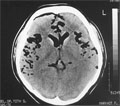The eLitMed.hu medical portal uses computer cookies for convenient operation. Detailed information can be found in the Cookie-policy.
Lege Artis Medicinae - 2002;12(02)
Content
[The importance of hormone replacement therapy in primary and secondary cardiovascular prevention]
[There has been increasing expectation in hormone replacement therapy (HRT) as a potentially useful preventive intervention. Observational studies indicated 50% relative risk reduction on ischaemic heart disease among current HRT users. Unfortunately, this has not been justified by the results of the large scale, prospective, placebo controlled, double blind secondary prevention trials. Even these trials underscored the potential adverse effects of hormone replacement therapy (thromboembolic complications, gall bladder disease). No results of completed primary prevention trials are available for the moment. Based on these data the AHA/ACC Science Advisory of 2001 recommends: HRT should not be recommended for secondary prevention There are insufficient data to suggest that HRT should be initiated for the sole purpose of primary prevention of cardiovascular diseases.]
[Tumour therapy with the tools of interventional radiology]
[The author reviews the interventional radiological methods applicable in tumour therapy. The therapy of non-resectable primary and secondary liver tumours is discussed based on literature data and own experience. The possibilities of percutaneous tumour ablation are limited by the size and number of the tumours. Intra-arterial chemotherapy, chemoembolisation and feeding artery occlusion can be successful resulting in longer life and better quality of life in cases with advanced tumours. The results are better if these methods are combined with systemic chemotherapy.]
[Recurrent meningitis caused by spontaneous liquorrhoea]
[INTRODUCTION - The most common and most important cause of recurrent meningitis is bacterial infection. In the majority of cases, recurrent episodes of bacterial meningitis are associated with certain anatomical abnormalities that enable bacteria to penetrate subarachnoideal space. Nasal liquorrhoea can arise via traumatic or non-traumatic way. Non-traumatic nasal liquorrhoea with normal pressure is either of congenital origin or "idiopathic" and is frequently called spontaneous liquorrhoea. Spontaneous liquorrhoea is a rare entity making up 3-4 % of nasal liquorrhoea. CASE REPORT - The patient presented in this study was initially treated with purulent meningitis. A diagnosis of Streptococcus pneumoniae infection was established by bacterial culture tests. After being discharged, the patient was free from complaints for a considerable period of time. Her recurrent symptoms of a running nose were diagnosed later as allergic rhinitis at an ambulatory examination. A year later the patient was readmitted to hospital with bacterial meningitis. Due to the noticeable rhinorrhea on admission, the initially suspected liquorrhoea was confirmed by an otorhinolaryngological examination. A CT scan of the cranium verified external and internal pneumocephalus. Through a nuclear medicine examination a liquor fistula communicating with the sphenoidal sinus was diagnosed. After recovering from the meningitis caused by ascending bacterial infection the patient successfully underwent a neurosurgical operation for a reconstruction of the cerebral base via frontal craniotomy. CONCLUSION - With this case presentation we wish to bring attention to the rare disorder of spontaneous cerebrospinal fluid rhinorrhea when treating recurrent meningitis.]
[Data on health-behaviour in samples from counties with high and low suicide rates]
[Authors conducted a comparative sociological, social-psychiatric survey in the summer of 2000 on a representative sample (1000- 1000 people) from counties with high and low suicide rates (Bács-Kiskun and Vas). They also studied the so-called "health-behaviour" of subjects since it was supposed that negation or refusal of medical help are forms of latent auto-agressivity, probably of common origin with "direct" self-harm (alcohol abuse, smoking, suicide), from deeper behavioural roots. The rates of morbidity and mortality of the two counties do not differ each other significantly with the exception of alcoholism. In spite of this facts, people living in the Great Hungarian Plain (Alföld) regard themselves in worse health condition than people in western countryside, presenting as patients in the health care system more frequently in the Alföld. Authors did not find any connection between the quality of health behaviour and the sharply divergent suicide rates of the two territories. Studying the two sample as a whole, they found marked problems in the field of health behaviour in both counties. They also stress that suicide and alcoholism in Hungary are very closely connected entities. Authors suggest that tasks for the public health service in this matter are significant.]
1.
Clinical Neuroscience
Is there any difference in mortality rates of atrial fibrillation detected before or after ischemic stroke?2.
Clinical Neuroscience
Factors influencing the level of stigma in Parkinson’s disease in western Turkey3.
Clinical Neuroscience
Neuropathic pain and mood disorders in earthquake survivors with peripheral nerve injuries4.
Journal of Nursing Theory and Practice
[Correlations of Sarcopenia, Frailty, Falls and Social Isolation – A Literature Review in the Light of Swedish Statistics]5.
Clinical Neuroscience
[Comparison of pain intensity measurements among patients with low-back pain]1.
Clinical Neuroscience Proceedings
[A Magyar Stroke Társaság XVIII. Kongresszusa és a Magyar Neuroszonológiai Társaság XV. Konferenciája. Absztraktfüzet]2.
3.
Journal of Nursing Theory and Practice
[A selection of the entries submitted to the literary contest "Honorable mission: the joys and challenges of our profession" ]4.
Journal of Nursing Theory and Practice
[End of Life and Palliative Care of Newborns in the Nursing Context]5.
Journal of Nursing Theory and Practice
[Aspects of Occupational Health Nursing for Incurable Patients ]











